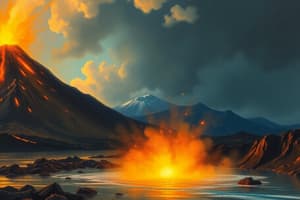Podcast
Questions and Answers
What is the meaning of the term 'geothermal'?
What is the meaning of the term 'geothermal'?
- Energy derived from volcanic eruptions
- Energy harnessed from the sun
- Energy produced by wind turbines
- Energy stored within the Earth's subsurface (correct)
Which country was home to the first geothermal power plant built in 1904?
Which country was home to the first geothermal power plant built in 1904?
- Iceland
- Japan
- United States
- Italy (correct)
How do flash steam geothermal power plants generate electricity?
How do flash steam geothermal power plants generate electricity?
- By utilizing a heat exchange fluid with a lower boiling point than water
- By directly using steam from geothermal reservoirs to turn turbines
- By collecting steam to harness for electricity production
- By using hot water from reservoirs to produce steam driving turbines (correct)
What distinguishes binary cycle geothermal power plants from other types?
What distinguishes binary cycle geothermal power plants from other types?
Which of the following is NOT a way geothermal power plants harness the Earth's heat?
Which of the following is NOT a way geothermal power plants harness the Earth's heat?
In which year was the first geothermal power plant constructed?
In which year was the first geothermal power plant constructed?
What distinguishes hydrothermal geothermal reservoirs from petroleum geothermal reservoirs?
What distinguishes hydrothermal geothermal reservoirs from petroleum geothermal reservoirs?
Why are most geothermal reservoirs found near tectonic plate boundaries?
Why are most geothermal reservoirs found near tectonic plate boundaries?
What makes geothermal power plants a reliable source of electricity?
What makes geothermal power plants a reliable source of electricity?
What is a major technological challenge faced by geothermal energy projects?
What is a major technological challenge faced by geothermal energy projects?
Why do volcanoes play a crucial role in the generation of geothermal energy?
Why do volcanoes play a crucial role in the generation of geothermal energy?
What is one advantage of geothermal power plants over other renewable energy sources like solar and wind?
What is one advantage of geothermal power plants over other renewable energy sources like solar and wind?
Flashcards are hidden until you start studying
Study Notes
Harnessing Energy from Volcanoes: Geothermal Power
Volcanoes have been shaping our planet for eons, with their fiery eruptions and molten depths holding a wealth of untapped energy. Geothermal energy, which harnesses the Earth's heat, has been quietly gaining attention as a reliable and renewable source of electricity. In this article, we'll explore geothermal energy from volcanoes, examining geothermal power plants, geothermal reservoirs, and the broader context of renewable energy sources.
Geothermal Energy
Geothermal energy, derived from the Greek words "geo" (Earth) and "therme" (heat), is the natural heat stored within the Earth's subsurface. This heat is a result of the planet's ongoing geological processes, as well as the slow decay of radioactive materials. Geothermal energy is one of the earliest sources of renewable energy, with the first geothermal power plant built in Larderello, Italy, in 1904.
Geothermal Power Plants
Geothermal power plants utilize the Earth's heat to produce electricity, harnessing it in three primary ways: dry steam, flash steam, and binary cycle power plants. Dry steam plants collect steam from geothermal reservoirs and use it directly to turn turbine generators. Flash steam plants pump hot water from reservoirs to the surface, where it is converted into steam and used to drive turbines. Binary cycle plants use a heat exchange fluid with a lower boiling point than water to generate steam and drive turbines.
Renewable Energy Sources
Geothermal energy joins other renewable energy sources, including solar, wind, and hydroelectric power, that are based on naturally replenishing resources. With the increasing global demand for energy and the urgent need to reduce greenhouse gas emissions, renewable energy sources are gaining prominence, as they produce little or no carbon emissions and have the potential to provide a sustainable energy future.
Geothermal Reservoirs
Geothermal reservoirs exist in two primary forms: hydrothermal and petroleum geothermal reservoirs. Hydrothermal reservoirs are filled with hot water and steam, while petroleum geothermal reservoirs contain hot water with dissolved gases, such as carbon dioxide and hydrogen sulfide. Both types of geothermal reservoirs are found near tectonic plate boundaries, such as along the Ring of Fire, where volcanic activity is common.
Volcanoes and Geothermal Energy
The relationship between volcanoes and geothermal energy is complex but undeniable. Volcanoes are often located along geothermal reservoirs due to their proximity to tectonic plate boundaries. This makes it easier to locate and harness geothermal energy. In addition, volcanoes' natural heating processes generate steam and hot water, which can be used to produce electricity. However, it's crucial to note that not all volcanoes are associated with geothermal energy. Most volcanic systems do not have the necessary geothermal reservoirs or the surface expression of geothermal fluids required to generate electricity.
Challenges and Opportunities
While geothermal energy is a promising renewable energy source, it does face challenges. These include the high initial cost of drilling and technological challenges, such as managing the complex geology and maintaining the infrastructure. However, geothermal energy also offers great opportunities, as it is a reliable, constant, and scalable source of electricity, capable of providing base-load power 24/7. Furthermore, geothermal power plants have a long operational lifespan and require minimal maintenance and fuel costs once they are up and running.
In conclusion, geothermal energy from volcanoes is an exciting and viable renewable energy source that harnesses the Earth's natural heat to produce electricity. With advancements in technology and greater investment in geothermal power plants, this energy source has the potential to contribute significantly to a sustainable global energy future.
Studying That Suits You
Use AI to generate personalized quizzes and flashcards to suit your learning preferences.




